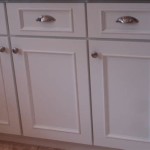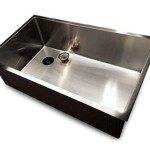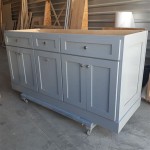Undermount Stainless Steel Kitchen Sinks: A Comprehensive Guide
Undermount stainless steel kitchen sinks represent a popular choice for homeowners seeking a blend of functionality, durability, and aesthetic appeal. Their installation method, where the sink is mounted beneath the countertop, contributes to a seamless and modern look. This article will explore the various aspects of undermount stainless steel kitchen sinks, including their advantages, disadvantages, types, installation considerations, maintenance, and factors to consider when making a purchase.
The kitchen sink is a central element in any kitchen, handling a variety of tasks from food preparation to dishwashing. The choice of sink material and mounting style significantly impacts the kitchen's overall functionality and aesthetic. Undermount stainless steel sinks offer a compelling combination of benefits, making them a favored option for both new constructions and kitchen renovations.
Advantages of Undermount Stainless Steel Sinks
Undermount stainless steel sinks offer several distinct advantages over other sink types. These advantages contribute to their widespread popularity and suitability for various kitchen designs.
Cleanliness and Hygiene: One of the primary benefits is the ease of cleaning. The absence of a rim between the sink and the countertop allows for effortless wiping of spills and crumbs directly into the sink. This seamless transition prevents the accumulation of dirt and bacteria, promoting a more hygienic kitchen environment. Traditional drop-in sinks, with their raised rims, often trap food particles and require more meticulous cleaning.
Modern Aesthetic: The undermount design creates a clean and contemporary look. The smooth, uninterrupted surface of the countertop enhances the overall visual appeal of the kitchen. The sink seamlessly integrates into the countertop, minimizing visual clutter and creating a more streamlined appearance. This modern aesthetic often appeals to homeowners seeking a minimalist and uncluttered kitchen design.
Increased Countertop Space: By being mounted underneath the countertop, undermount sinks effectively maximize usable countertop space. The absence of a visible rim around the sink allows for greater flexibility in countertop design and utilization. This increased space is particularly beneficial in smaller kitchens where every inch of countertop is valuable. It allows for more efficient food preparation and other kitchen tasks.
Versatility: Stainless steel is a highly versatile material that complements a wide range of kitchen styles and color palettes. The neutral appearance of stainless steel allows it to blend seamlessly with various countertop materials, cabinet finishes, and appliance colors. Whether the kitchen design is modern, traditional, or transitional, a stainless steel undermount sink can be a suitable choice.
Durability and Longevity: Stainless steel is known for its durability and resistance to corrosion, rust, and stains. A high-quality stainless steel sink can withstand daily use and maintain its appearance for many years. Its non-porous surface prevents the absorption of liquids and odors, further contributing to its longevity and hygiene.
Disadvantages of Undermount Stainless Steel Sinks
While undermount stainless steel sinks offer numerous advantages, there are also some potential drawbacks to consider before making a purchase.
Installation Complexity: Undermount sinks generally require professional installation. The installation process involves carefully securing the sink to the underside of the countertop using clips and adhesive. This process can be more complex than installing a drop-in sink, which simply rests on top of the countertop. Improper installation can lead to leaks or structural issues.
Countertop Material Restrictions: Undermount sinks are best suited for solid surface countertops such as granite, quartz, or solid acrylic. Laminate countertops are generally not recommended because they are susceptible to water damage and may not provide sufficient support for the sink's weight. The weight of the sink and the water it contains is supported entirely by the countertop, requiring a strong and water-resistant material.
Potential for Water Damage: Although stainless steel is resistant to water damage, the area where the sink meets the countertop is susceptible to leaks if not properly sealed. The silicone caulk used to seal the seam between the sink and the countertop can deteriorate over time, requiring periodic reapplication. Regular inspection and maintenance are essential to prevent water damage.
Cost: Undermount sinks, along with the associated professional installation costs, may be more expensive than drop-in sinks. The higher cost reflects the more complex installation process and the materials used to secure the sink to the countertop. However, the long-term benefits of durability and aesthetic appeal may outweigh the initial cost for many homeowners.
Noise: Stainless steel sinks can sometimes be noisy, particularly when washing dishes or running water. The sound of water impacting the stainless steel surface can be amplified, creating a potentially disruptive noise level. However, this issue can be mitigated by choosing a sink with sound-dampening pads or a thicker gauge of stainless steel.
Types of Undermount Stainless Steel Sinks
Undermount stainless steel sinks are available in a variety of configurations and styles to suit different kitchen needs and preferences.
Single Bowl Sinks: Single bowl sinks consist of a single large basin. They are a popular choice for smaller kitchens or for homeowners who prefer a simple and uncluttered design. Single bowl sinks offer ample space for washing large pots and pans.
Double Bowl Sinks: Double bowl sinks feature two separate basins, allowing for multitasking. One basin can be used for washing dishes, while the other can be used for rinsing or drying. Double bowl sinks are often preferred by homeowners who frequently cook and wash dishes.
Equal Bowl Sinks: Equal bowl sinks have two basins of the same size. This configuration is ideal for tasks that require two identical spaces, such as washing produce or soaking dishes.
Unequal Bowl Sinks: Unequal bowl sinks have two basins of different sizes. This configuration offers flexibility for various tasks. The larger basin can be used for washing large items, while the smaller basin can be used for food preparation or rinsing.
Farmhouse Sinks: Although traditionally installed as drop-in sinks, farmhouse style sinks are also available in undermount configurations. These sinks feature an exposed front apron that extends beyond the countertop, creating a distinctive and rustic look. Undermount farmhouse sinks offer a seamless transition between the countertop and the sink, enhancing their visual appeal.
Corner Sinks: Corner sinks are designed to fit into the corner of a kitchen, maximizing space utilization. They are available in both single and double bowl configurations and can be a practical solution for smaller kitchens with limited countertop space.
Factors to Consider When Purchasing an Undermount Stainless Steel Sink
Selecting the right undermount stainless steel sink requires careful consideration of several factors to ensure that it meets your specific needs and preferences.
Gauge of Stainless Steel: The gauge of stainless steel refers to its thickness. A lower gauge number indicates a thicker steel. Thicker stainless steel is more durable and resistant to dents and scratches. A gauge of 16 or 18 is generally recommended for kitchen sinks.
Stainless Steel Grade: The grade of stainless steel determines its resistance to corrosion and rust. 304-grade stainless steel is the most common and widely recommended grade for kitchen sinks due to its excellent corrosion resistance and durability. Lower grades of stainless steel may be more susceptible to rust and staining.
Sink Dimensions: Consider the size and depth of the sink bowls to ensure that they are adequate for your needs. Measure the available space in your countertop and cabinets to ensure that the sink will fit properly. The depth of the sink should be sufficient to accommodate large pots and pans without making it difficult to reach the bottom.
Bowl Configuration: Choose a bowl configuration that suits your cooking and cleaning habits. Single bowl sinks are ideal for washing large items, while double bowl sinks offer versatility for multitasking. Consider whether you prefer equal or unequal bowl sizes based on your specific needs.
Sound Dampening: Look for sinks with sound-dampening pads or coatings to minimize noise. These features help absorb the sound of water and dishes, creating a quieter kitchen environment. The quality and coverage of the sound-dampening material can significantly impact the sink's noise level.
Finish: Stainless steel sinks are available in various finishes, including brushed, polished, and satin. The finish affects the sink's appearance and its resistance to scratches and stains. Brushed finishes are generally more resistant to scratches than polished finishes.
Installation Considerations for Undermount Stainless Steel Sinks
Proper installation is crucial to ensure the longevity and performance of an undermount stainless steel sink. While DIY installation is possible, professional installation is generally recommended to avoid potential problems.
Countertop Preparation: The countertop must be properly prepared to accommodate the sink. This involves cutting a precise opening in the countertop and ensuring that the edges are smooth and clean. The countertop material must be strong enough to support the weight of the sink and the water it contains.
Securing the Sink: The sink is typically secured to the underside of the countertop using clips and adhesive. The clips must be evenly spaced and properly tightened to ensure a secure and level installation. The adhesive helps to create a watertight seal and prevent the sink from shifting.
Plumbing Connections: Proper plumbing connections are essential to prevent leaks and ensure proper drainage. The drainpipe must be securely connected to the sink's drain and the water supply lines must be properly connected to the faucet. Check all connections for leaks before using the sink.
Sealing the Seam: The seam between the sink and the countertop must be properly sealed with silicone caulk to prevent water damage. The caulk should be applied smoothly and evenly along the entire perimeter of the sink. Regular inspection and reapplication of the caulk may be necessary to maintain a watertight seal.
Maintenance of Undermount Stainless Steel Sinks
Proper maintenance is essential to keep an undermount stainless steel sink looking its best and to prolong its lifespan.
Regular Cleaning: Clean the sink regularly with a mild soap and water. Avoid using abrasive cleaners or scouring pads, as they can scratch the surface of the stainless steel. Rinse the sink thoroughly after cleaning and dry it with a soft cloth to prevent water spots.
Removing Stains: To remove stubborn stains, use a stainless steel cleaner or a paste of baking soda and water. Apply the cleaner or paste to the stain and gently scrub with a soft cloth or sponge. Rinse thoroughly and dry with a clean cloth.
Preventing Water Spots: To prevent water spots, dry the sink after each use. You can also use a stainless steel polish to create a protective barrier that repels water and prevents spotting.
Avoiding Harsh Chemicals: Avoid using harsh chemicals such as bleach or ammonia on stainless steel sinks. These chemicals can damage the surface of the stainless steel and cause discoloration.
Protecting the Sink Bottom: Use a sink grid or mat to protect the bottom of the sink from scratches and dents. This is especially important if you frequently wash heavy pots and pans.

Undermount Kitchen Sinks Zuhnesg

Supply Big Single Bowl Undermount Handmade Sus304 Stainless Steel Kitchen Sinks Factory Quotes Higold Group

Undermount Kitchen Sinks Zuhnesg

Rubine Forte Series Fox 610 59 U Single Bowl Undermount Stainless Steel Sink

Shop Best Undermount Kitchen Sinks The Sink Boutique Free Shipping

Ruvati 28 Inch Undermount Kitchen Sink 50 Double Bowl 16 Gauge Stainless Steel Rvm5077 Usa

Ks Dn S3440 Stainless Steel Kitchen Sinks

Undermount Kitchen Sinks By Blanco

Ks Dn Es281616 Stainless Steel Kitchen Sinks

Supply Big Single Bowl Undermount Handmade Sus304 Stainless Steel Kitchen Sinks Factory Quotes Higold Group








